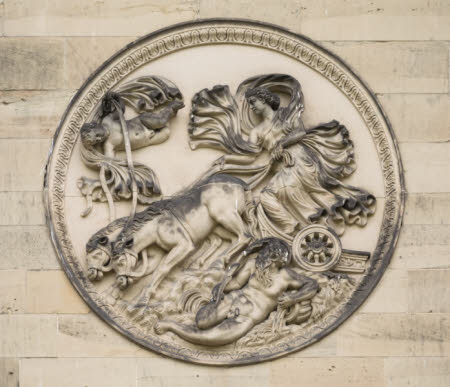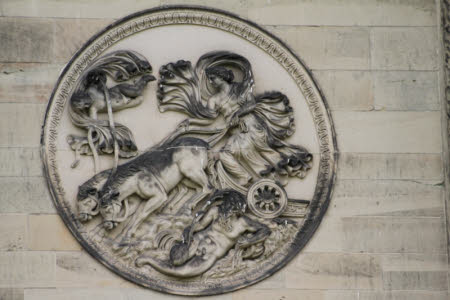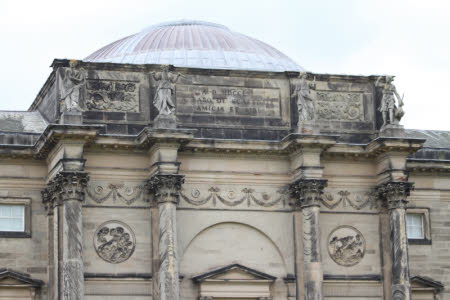Night, Diana (Luna) driving the Chariot of the Moon
British (English) School
Category
Art / Sculpture
Date
circa 1758 - circa 1763
Materials
Stone
Place of origin
Great Britain
Order this imageCollection
Kedleston Hall, Derbyshire
NT 108051
Summary
Stone, Night, Diana (Luna) driving the Chariot of the Moon, bringing night, British (English) School, c. 1760-63. A medallion carved of stone depicting Diana, Roman goddess of the hunt, the moon and nature, as Luna, driving the Chariot of the Moon, a two-yoke chariot (a biga) which brings night. Diana wears a lunate crown and robes which billow in the wind. She is preceded by the winged figure of Hesperus, personification of the Evening Star, who holds the reins directing Diana's horses. At bottom right is Oceanus, the divinity who personifies the sea, the great river encircling the world which separates the habitable world from the underworld. One of a pair of medallions carved by local stone masons installed on the South Front exterior of Kedleston Hall. The medallions are after Hadrianic tondi on the Arch of Constantine, Rome (with NT 108052, depicting the sun god Apollo, as Sol, driving his four-horse chariot (a quadriga) which brings day). In the original tondo on the Arch of Constantine the image is reversed, with Diana and Oceanus at left and Hesperus at top right.
Full description
The medallions are part of a scheme of decoration on theme of time and the seasons: Diana (Luna) and Apollo (Sol/Helios) signifying night and day and the lead statues of Flora and Bacchus below the tondi signifying Spring and Autumn (NT 108712.1 and 108712.2). As a whole, the South Front was designed to combine architectural and decorative elements from the Arch of Constantine and the Pantheon in Rome, where a rotunda is approached through a Corinthian portico or temple-front. Diana, as huntress, is seen again in South Front portico pediment statuary (NT 108050), along with statues of Prudence (NT 108049) and two of the muses (NT 108047, 108048). Archival evidence shows that Nathaniel Curzon (1726-1804) had medallions of Diana and Apollo in mind for the South Front from c.1760. In his manuscript 'List of Statues I have', an itemised record of the sculpture and statuary collection at Kedleston, Curzon noted that 'Basso relievo for the Medallions on the South' were to be 'Apollo driving his Car' 'Next the East Court' and 'Diana driving her Car' 'Next the Church' (MS, Kedleston Archive). The note also refers to a plate in Joseph Spence's Polymetis (1747), the standard reference for classical mythology and iconography throughout the eighteenth century. Curzon cites 'Spence Plate 26' (nos. 3 and 4) which depict 'Luna, in her Chariot...a Relievo; formerly on Trajan's Arch, and now on Constantine's, at Rome'. and 'Sol, in his Chariot...a Medal, of Antioninus Pius, in the Great Duke's collections, at Florence' (Spence 1747, p. 333, pl. XXVI, see also pp. 184-6). Similar tondi were produced by Thomas Banks (1735-1805) for the architect Sir John Soane (Sir John Soane's Museum, inv.no. A1 and A90, with associated or preparatory tondi M32, M16 (terracotta), SDR5 and SDR15). Alice Rylance-Watson 2019
Provenance
Commissioned by Nathaniel Curzon, 1st Baron Scarsdale (1726-1804), c.1760-63; identifiable in 'List of Statues I have' as 'Basso relievo for the Medallions on the South' (MS, Kedleston Archive); identifiable in the published 'Catalogue of the pictures, statues, &c. at Kedleston' (1769) p. 4, 'Medallions of Apollo and Diana'; purchased with part of the contents of Kedleston with the aid of the National Heritage Memorial Fund in 1987 when the house and park were given to the National Trust by Francis Curzon, 3rd Viscount Scarsdale (1924-2000).
Credit line
Kedleston Hall, The Scarsdale Collection (acquired with the help of the National Heritage Memorial Fund and transferred to The National Trust in 1987)
Makers and roles
British (English) School, carver


